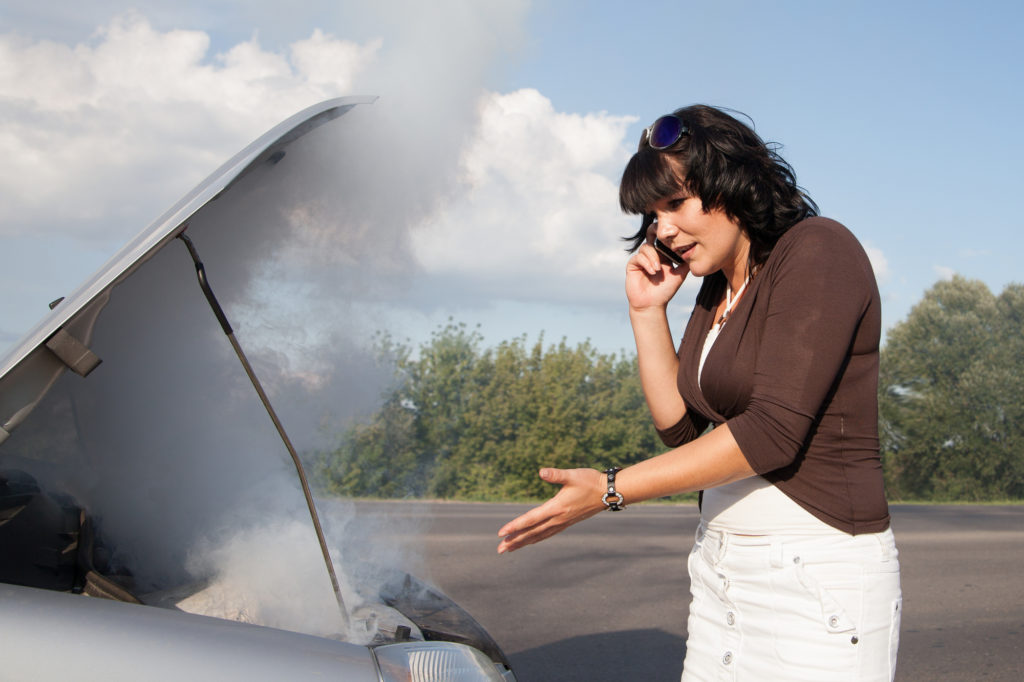It can be a scary thing when your car warns you that it’s overheating. A hot engine can cause plenty of problems if not taken care of right away. In the worst-case scenarios, you may find yourself broken down on the side of the road, smoke coming out of your engine.
An overheating car can lead to massive engine damage. Your engine can crack under the heat and begin to leak oil. Also, your head gasket, cylinders, and pistons can all warp. In the best-case scenario, you may lose some performance. At the worst, your entire engine can seize.
To proactively avoid these issues, it’s essential to keep an eye on your car’s temperature gauge. But what if all the signs point towards a hot engine, but it’s not overheating? This article will cover what the means and what to do in that particular situation.

Contents
Why Is My Car Running Hot But Not Overheating?
There are a few reasons why your car may be hot but not overheating. Most of these reasons are related to your cooling system. It may be that your radiator is clogged or damaged, that your coolant is low, that your water pump is damaged, that your thermostat is damaged, or that your engine is simply overworked.
In some cases, you may find that everything appears to be perfectly fine with your cooling system. In such cases, it could be simply that your cooling system is in need of a tune-up to work more efficiently. It could be as simple as changing out your coolant to stop your car from running hot.
5 Symptoms and Causes Of A Car Running Hot But Not Overheating
As stated above, the most common reasons for an engine to run hot but not overheat include:
– Radiator clogged or damaged
– Low coolant
– Water pump damage
– Thermostat damage
– Overworked engine.
These five issues all have different symptoms that may indicate what the problem is.
If The Temperature Gauge Reading Fluctuates
This is for those moments that the temperate seems to rise dramatically and then go back to normal. Perhaps you are stopped or accelerating on the highway, and all of a sudden, your temperature gauge is reading high, but the moment you go to check out the issue, the temperature has returned to normal. What is the problem here?
The problem is rarely the temperature gauge itself. While not impossible, the gauge is generally known to outlive the life of the car. Instead, the temperature gauge gives some indication of what the problem may be.
The most common reason for a temperature fluctuating in this way is a broken thermostat. Thankfully a thermostat is relatively cheap and easy to replace.
A dying radiator fan may also be the cause. If it is the fan, you may notice the fan making a strange noise, and you will be able to see it spinning weirdly.
The cylinder head gasket may also be a culprit. When the engine gets hot, this is often the first thing to break. A damaged gasket will cause a coolant leak into the engine oil.
Lastly, if you don’t have enough coolant, you may have this problem.
If The Temperature Gague Reading Is High
If your temperature gauge is consistently running high, there may be four reasons for this.
One, it may simply mean that your engine is overheating.
Two, you may be leaking coolant.
Three, like the fluctuating temperature, you may have a broken thermostat.
And finally, if your car is running hot, it may mean that you need your water pump or water pump basket replaced.
If The Temperature Gauge Reading is Low
If you notice that your engine is steaming, but your temperature gauge is still reading low, then there may be some reasons for it.
One, if you notice that the temperature gauge is still reading as cold even after the vehicle has had time to warm up, then it may be the temperature gauge itself that needs to be replaced. Generally, the temperature gauge will only read cold when the engine isn’t running.
Second, it could be that the thermostat is stuck open. In the case that the vehicle is overcooled, the thermostat can get stuck open, meaning that it will only read cold afterward. In this case, the thermostat will need to be replaced.
What You Should Do It Your Car Runs Hot
First, let’s go over some signs that your car is overheating. First off, you may have steam coming out of the hood. If you get near the hood of the car, you may notice that it is hot. There could also be coolant leaking on the ground or a strange smell.
While the car is still running, you may notice a ticking or thumping noise coming from the engine. Additionally, you may see that you are not getting as much power from your engine.
The temperature gauge is not often the problem with an overheating car. Instead, it is usually the first indicator that something is wrong. In the rare chance that the temperature gauge is broken, however, you will notice one of two things. Either the temperature reading will highly fluctuate, or the temperature reading will just remain cold.
If your system that your temperature gauge is the issue, you can test it with a multimeter to check that it’s running correctly. The first step to performing this test is to locate your temperature gauge. In most vehicles, it will be housed near the thermostat. There is a chance, however, that it will be attached to a cylinder head. If you still can’t find it, try following the upper radiator hose.
Once you have located your temperature gauge, you will be able to use a multimeter to measure the coolant temperature gauge’s resistance value. The expected value should be in your car’s manual. If not, you should be able to look it up online. Most vehicles will have a resistance value of 3000 ohms at 55F.
To test your resistance level, connect one of the multimeter’s leads to the sensor’s electrical connector terminal. The other lead will be connected to a different terminal. From here, take your readings. You will want to take readings when your car is turned off, when it is turned on and warmed up, and when it is turned off again. Compare your readings to those from the manual.
While performing these tests, if your notice the gauge has 0 resistance, there is no change while the car warms up, there are damaged wires, or the gauge itself appears damaged, then it will need to be replaced.

How To Treat Symptoms Of A Car Running Hot But Not Overheating
If you notice that your vehicle is overheating, there are a few things that you can do to avoid damage to your engine.
1. Pull over as soon as it is safe to do so. The main thing that you can do for a hot car is to stop driving it. By pulling over and shutting off the vehicle, you are giving the engine time to come back down to a regular temperature. While you’re waiting, watch the temperature gauge to make sure that it is going down. Since it probably isn’t a good idea to keep driving it beyond this point, feel free to call a friend or a tow service.
2. Turn off the A/C and turn up the heat. This one may seem counterintuitive, but running the A/C can actually add stress to your engine. Then by turning on the heat, you will be pulling heat away from the engine and into the car. This is a great option if you can’t pull over right away and need to keep driving for a little while first.
3. Check the coolant. In many situations where the car is overheating, the issue is often related to low or leaking coolant. Check your coolant level once you are safely pulled over. If you have any with you, add more coolant. If you don’t know where your coolant reservoir is, you can consult your car’s manual.
4. Start the engine. After you’ve given your car plenty of time to cool down, try starting the engine again. Keep an eye on the temperature gauge to make sure that your car doesn’t start to overheat again. If you need to, this would be the time to start (carefully) driving towards the nearest garage. As you drive, keep an eye on the temperature gauge and pull over again if you notice that the car is starting to overheat.
FAQ
Why Is My Car Overheating, But My Temperature Gauge Is Normal?
This is usually one of two things. Either the thermostat is broken and no longer taking reading correctly, or the temperature gauge is broken.
Another option is that you have a faulty radiator cap. If the radiator cap isn’t sealed correctly, steam will escape from your radiator, even if the car isn’t overheating. This will make it look as though it’s overheating even though the temperature gauge says everything is okay.
Why Is My Car Overheating, but It Has Coolant in It?
If there is coolant in your car and it is still overheating, it’s likely that the problem is the coolant isn’t able to circulate correctly. This can be caused by a broken water pump, a stuck thermostat, a blockage in your radiator, or a plugged heater core.
Why Is My Car Overheating but No Smoke Under the Hood?
Not every overheating car is going to smoke and burn. If there’s no smoke, it could be that your coolant is low. Also, there could be an issue with the thermostat, or the coolant may not be circulating through the radiator correctly.
How Long Can I Drive My Car While It’s Running Hot?
If your car is already overheating, you don’t want to drive it any further than a quarter-mile. As soon as you notice that it’s overheating, pull over as soon as it’s safe to do so. If you can, call a tow truck. If you can’t call a tow truck, then wait for your car to cool down and carefully drive towards a garage while keeping an eye on the temperature gauge. If it starts to overheat again, pull over again.
Is It Normal for the Car Hood to Be Hot?
Under normal circumstances, it is completely okay for your car hood to be a little warm while the car is running. If you can comfortably hold your hand on your hood for at least ten seconds, then it’s fine.
However, if it is noticeably extremely hot, then that may be cause for concern.
What Is the Normal Temperature Gauge Reading of a Car Engine?
Your car temperature gauge is usually just an arrow that fluctuates between C for cold and H for hot. When the car is cooled down, the error should be pointed at C. When the car is running, the arrow should be in about the middle, give or take.
The temperature of the engine when it is running normally should be somewhere between 195 and 220 Fahrenheit.
How to Know if My Engine Is Damaged From Overheating?
When you inspect your engine, there are a few tell-tale signs that the engine was damaged from overheating. These include a cracked engine block, broken head gasket, warped cylinders, and melted or cracked seals.
How Often Do You Need to Replace Your Temperature Sensor?
When it comes to the normal running of a car, the temperature sensor should be replaced about every 100,000 miles. However, if the car wasn’t properly maintained, you may find the sensor failing before then.














